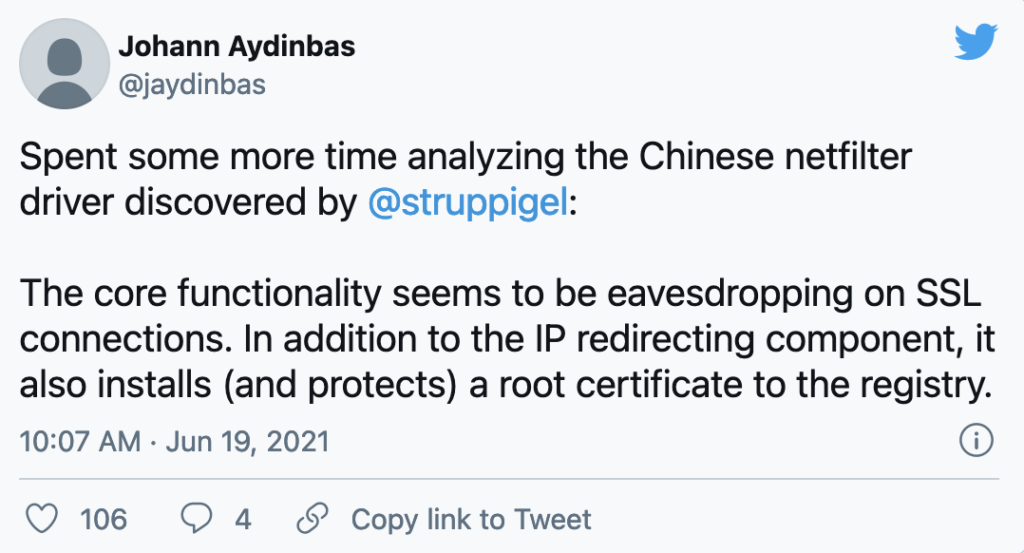I found this article from arstechnica interesting. The reason why is it is important to point out that mistakes happen. Digitally signed software is supposed to be blessed as safe but somethings things go wrong. The same concept applies to supply chain. Things are supposed to be safe when you buy them but sometimes things can go wrong. If you are responsible for security, you must consider a backup plane when things go wrong.
This article explains how Microsoft signed a rootkit meaning the software would be authorized and seem safe but allow a rootkit to be installed. Microsoft has responded and handled this situation but again, its important to know that mistakes can happen. The original article can be found HERE.
Microsoft gave its digital imprimatur to a rootkit that decrypted encrypted communications and sent them to attacker-controlled servers, the company and outside researchers said.
The blunder allowed the malware to be installed on Windows machines without users receiving a security warning or needing to take additional steps. For the past 13 years, Microsoft has required third-party drivers and other code that runs in the Windows kernel to be tested and digitally signed by the OS maker to ensure stability and security. Without a Microsoft certificate, these types of programs can’t be installed by default.
Eavesdropping on SSL connections
Earlier this month, Karsten Hahn, a researcher at security firm G Data, found that his company’s malware detection system flagged a driver named Netfilter. He initially thought the detection was a false positive because Microsoft had digitally signed Netfilter under the company’s Windows Hardware Compatibility Program.
After further testing, Hahn determined that the detection wasn’t a false positive. He and fellow researchers decided to figure out precisely what the malware does.
“The core functionality seems to be eavesdropping on SSL connections,” reverse engineer Johann Aydinbas wrote on Twitter. “In addition to the IP redirecting component, it also installs (and protects) a root certificate to the registry.”

A rootkit is a type of malware that is written in a way that prevents it from being viewed in file directories, task monitors, and other standard OS functions. A root certificate is used to authenticate traffic sent through connections protected by the Transport Layer Security protocol, which encrypts data in transit and ensures the server to which a user is connected is genuine and not an imposter. Normally, TLS certificates are issued by a Windows-trusted certificate authority (or CA). By installing a root certificate in Windows itself, hackers can bypass the CA requirement.
Microsoft’s digital signature, along with the root certificate the malware installed, gave the malware stealth and the ability to send decrypted TLS traffic to hxxp://110.42.4.180:2081/s.
Serious security lapse
In a brief post from Friday, Microsoft wrote, “Microsoft is investigating a malicious actor distributing malicious drivers within gaming environments. The actor submitted drivers for certification through the Windows Hardware Compatibility Program. The drivers were built by a third party. We have suspended the account and reviewed their submissions for additional signs of malware.”
The post said that Microsoft has found no evidence that either its signing certificate for the Windows Hardware Compatibility Program or its WHCP signing infrastructure had been compromised. The company has since added Netfilter detections to the Windows Defender AV engine built into Windows and provided the detections to other AV providers. The company also suspended the account that submitted Netfilter and reviewed previous submissions for signs of additional malware.
Microsoft added:
The actor’s activity is limited to the gaming sector, specifically in China, and does not appear to target enterprise environments. We are not attributing this to a nation-state actor at this time. The actor’s goal is to use the driver to spoof their geo-location to cheat the system and play from anywhere. The malware enables them to gain an advantage in games and possibly exploit other players by compromising their accounts through common tools like keyloggers.
It’s important to understand that the techniques used in this attack occur post-exploitation, meaning an attacker must either have already gained administrative privileges in order to be able to run the installer to update the registry and install the malicious driver the next time the system boots or convince the user to do it on their behalf.
Despite the limitations the post noted, the lapse is serious. Microsoft’s certification program is designed to block precisely the kind of attack G Data first discovered. Microsoft has yet to say how it came to digitally sign the malware. Company representatives declined to provide an explanation.